6 Common Mooring Methods Used For Ships
Each vessel has been designed with mooring arrangements such that ropes and wires of recommended strength can help it moor safely alongside a berth, floating platform, buoy or jetty. Fundamentally a vessel has to be positioned alongside a jetty or a berth, between mooring buoys, to a mooring buoy, to another ship or barge and then made fast using her own anchors, mooring lines or shorelines.
Some very common methods of mooring are Mediterranean mooring, Baltic mooring, Running mooring, Standing mooring, Spider mooring buoys, Single-point or single buoy mooring, Conventional or multi buoy mooring, Ship to Ship Mooring
While Moored alongside a fixed or floating jetty or a sea berth there are various forces acting on the vessel such as wind, current, tide, wave action, swell, surging induced due to passing ships and trim of the vessel.
The spring, breast and head lines prevent the vessel’s movement against the action of these forces. The directional effect of these need not be unidirectional. It can be multi-directional or at various angles to the vessel.
The resultant direction of these forces often changes with changes in direction of onshore/offshore winds or tidal streams, currents upriver and down streams. Thus a combination of breast ropes, head ropes and spring ropes is the best method to counter these forces and keep the vessel safely alongside.
Often mixed moorings are observed as some terminals based on local conditions and experiences require vessels to use more lines than they are designed for. Thus the method in which wires in conjunction with soft ropes with different SWL and construction are used as well is termed Mixed mooring.
The simplified resultant of these forces would tend to move a vessel in the transverse or longitudinal direction with respect to the jetty. Thus spring lines prevent the longitudinal motion and the breast lines check the transverse motion.
It is always preferred to avoid mixed moorings due to variable loads and elasticity of various kinds of ropes and wires which lead to different strains or weights on the lines. This can result in excessive loads on some lines than others and eventually part them putting the vessel in danger. However, for safety reasons or in a desperate situation shipmasters or pilots may have to resort to mixed moorings.
Vessels sometimes also use the seaward anchor in conjunction with mooring lines to haul the vessel out of the jetty while casting off or while making fast the vessel alongside use the seaward anchor to assist the control of the rate of lateral movement towards the berth. This manoeuvre can be carried out with or without the assistance of tugs.
Ship to Ship transfer operation involves mooring alongside two different or same sized ships for cargo transfer. During this operation, either one of the ships is at anchor or both are underway.
The mooring arrangement depends on the size of the ships. A vessel either at anchor or stopped and maintaining a constant heading is approached by the manoeuvring ship at an angle of approach as smaller as practicable. The region of approach is usually abaft the beam of the constant heading ship.
During the approach as the manoeuvring ship comes closer, it steers a course parallel to the heading or course of the other ship and reduces the horizontal distance between ships to less than 100 metres. Once this state is achieved the manoeuvring ship uses engine and rudder movements and reduces this distance further until the fenders touch each other.
The two ships thus then make parallel contact and the lines are passed respectively as per the mooring plan. As a common practice during the approach, the wind and sea are preferred to be from ahead or at very small angles to the bow.
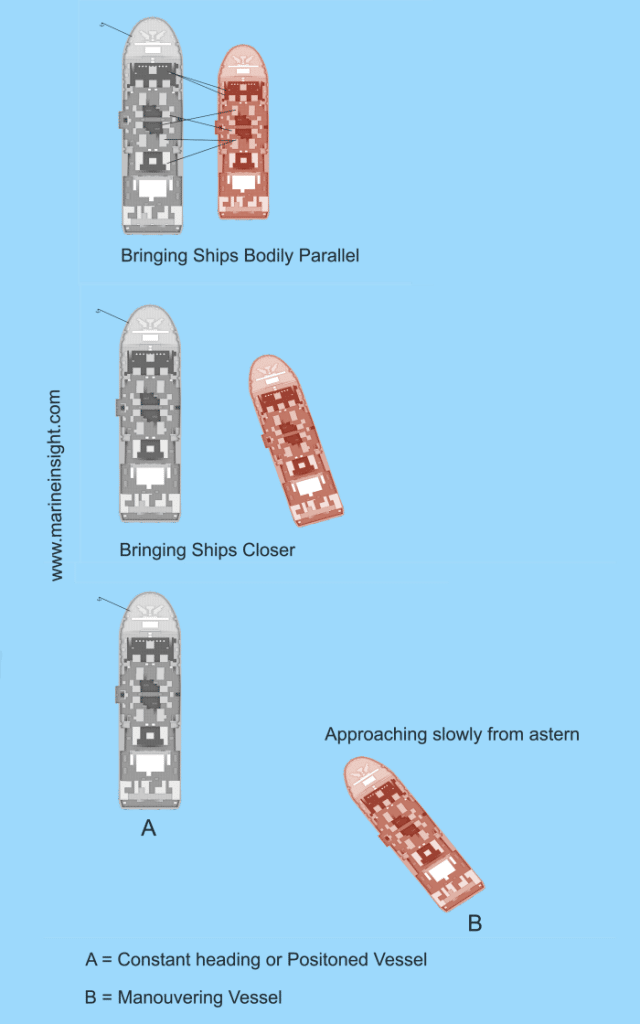
Single buoy or single point mooring: Often larger ships that cannot approach ports and terminals are berthed outside the port limits or in sheltered anchorages and the cargo transfer carried out with the help of Single-point or single buoy moorings.
The basic principle of the buoy is to keep the position of the vessel with respect to the buoy steady and at the same time allowing vessels to swing to wind and sea..
Often a tug is provided at the aft to keep the ship at a fixed angle and distance from the buoy. The buoy is fixed by positioning it in the centre of four anchors connected to it. The ship is made fast to the buoy with the help of a single chain or two which is secured onboard to the bow stopper.
In general, while approaching Single point or single buoy moorings weather is a major criteria in determining whether to berth the vessel or not. Calm seas with low swell and wind force below 15kts are considered favourable to make an approach. Presence of strong tidal current limits the interval for berthing and unberthing.
The headway approach has to be slow often less than while at the same time approaching at a smaller angle to the buoy and then gradually hauling in the buoy messenger rope and pulling the vessel slowly towards the buoy using engine kicks at short intervals to control and maintain headway along with mooring winches to haul in the vessel when she nears about 150-200 meters from the buoy.
For unberthing the chain is released from the bow stopper and a short kick on the engines going astern swings the bow to starboard for right-handed propellers thus clearing the vessel of the buoy. Tug’s assistance can also be sued to pull the vessel astern and clear it of the buoy. Know more about single point mooring here.

Conventional buoy or multi buoy mooring: In this method, the bow of the ship is secured using both her anchors whereas the stern is secured to buoy around it. In the approach firstly vessel approaches the final berthing position from forward at an angle of 90 degrees to her final direction of berthing.
The starboard anchor is then let go first at a pre-decided spot while the ship is making headway. The required amount of cable is paid and the astern propulsion too operated simultaneously to stop the vessel. Once the vessel is stopped in the water port anchor is let go and thus vessel positions her stern along the centerline bifurcating the buoys.
For aligning the vessel along this centerline port cable is paid out and starboard cable heaved in with astern propulsion. The helm and engines are to be carefully used during this manoeuvre to ensure the stern is swinging clear of any of the buoys.
During unberthing, the anchor cables are heaved in to move the vessel forward and the weight is taken on windward lines while casting off other lines to prevent swinging of the stern into the other buoys. This manoeuvre requires skill and efficient operation of the ship’s crew as well as of the mooring equipment as often weight of the lines can be immense.
Mediterranean mooring: For this type of mooring, a pre-calculated position is determined and approached using engine movements. The bow initially is made to cant towards the berth and the starboard anchor is let go in that position.
After this, the engines are run astern and the port anchor is let go at the designated spot. The vessel falls astern and swings to starboard. Thus vessel is held by both the anchors as it approaches the quay. Stern lines are then passed. Moorings are kept tight by using the anchor cables.
The positioning of the vessel is such that mooring is completed with around four shackles on each anchor. Often tide is used to control the drift of the vessel towards the quay while positioning it by heaving or paying out on one of the anchors. Read more on mediterranean mooring here.
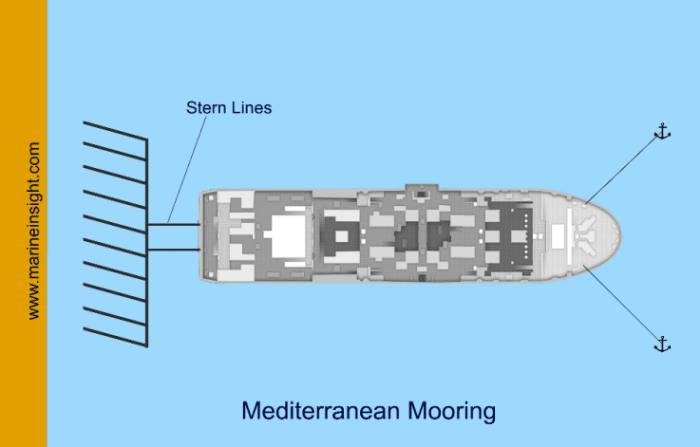
Running Mooring: This manoeuvre takes a relatively short duration compared to the Mediterranean mooring and offers more control of the vessel. The vessel’s starboard anchor is let go at a position approximately four to five shackles from the final position of the bow and around 9 shackles paid out while moving ahead on engines.
Then as she falls astern with the tide the port anchor is let go and the starboard anchor is heaved onto five shackles. This method restricts the swinging room and reduces the load on the windlass.
Standing Mooring: This is practised during crosswinds. As the vessel is stopped the port anchor is let go and with the tide around 9 shackles are paid out. The starboard anchor is let go and simultaneously port anchor heaved on.
Thus the port anchor is kept on 4 shackles being generally the flood anchor and starboard on five as it is the ebb anchor. This vessel takes longer duration and provides less control over the vessel. The load on the windlass is more as compared to running moor.
Over to you..
Do you know any other important mooring methods that can be added to this list?
Let’s know in the comments below.
Do you have info to share with us ? Suggest a correction

About Author
Abhishek Bhanawat is a chief officer who has worked on various types of tankers. He specializes in Crude Oil and Product Tankers. He is highly passionate about his work and loves to sail.
Latest Marine Navigation Articles You Would Like:
Subscribe To Our Newsletters
By subscribing, you agree to our Privacy Policy and may receive occasional deal communications; you can unsubscribe anytime.



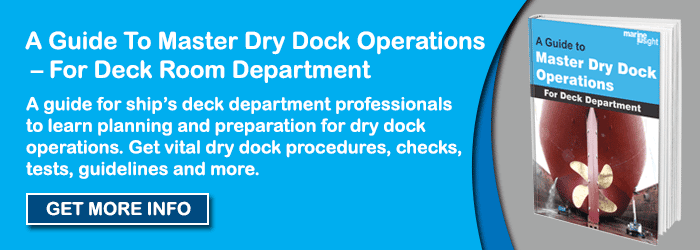
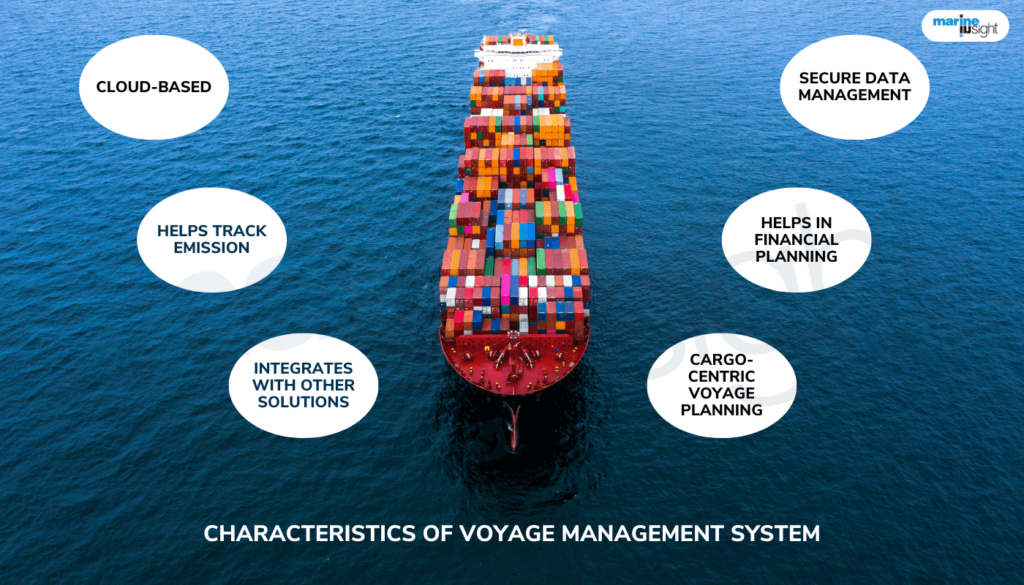
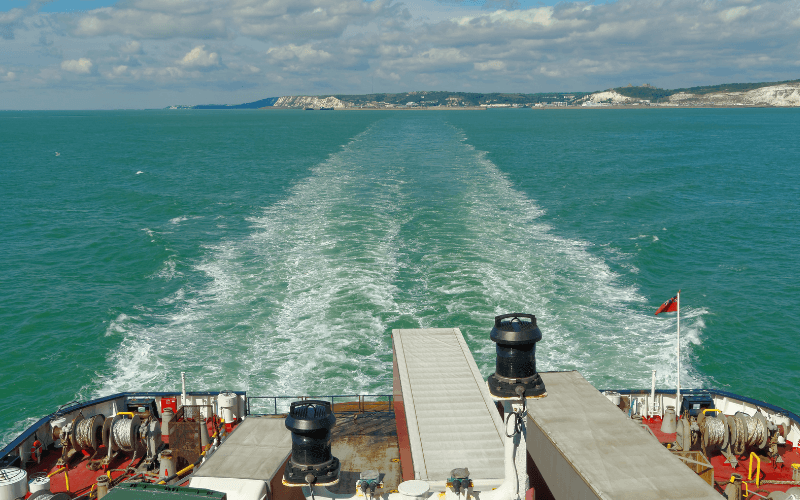
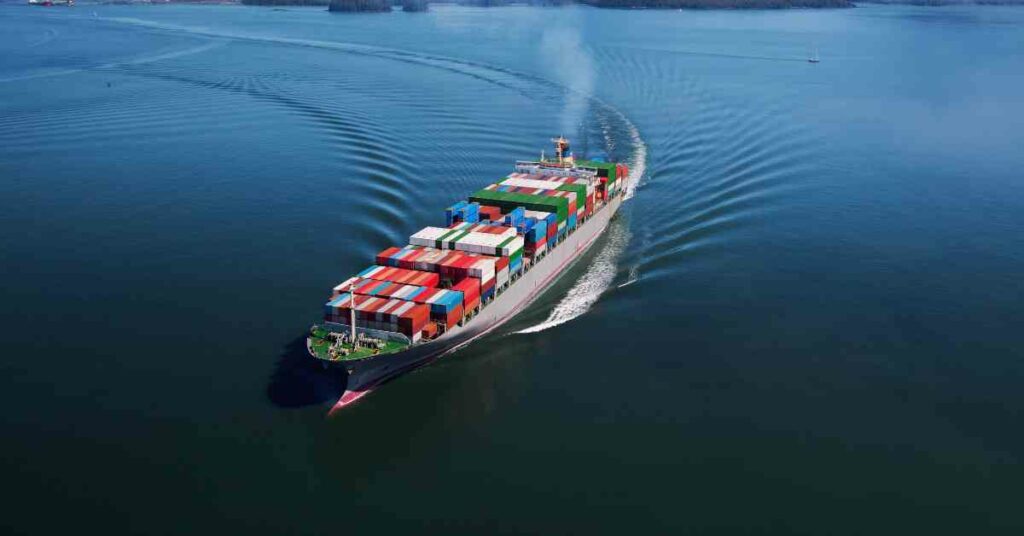
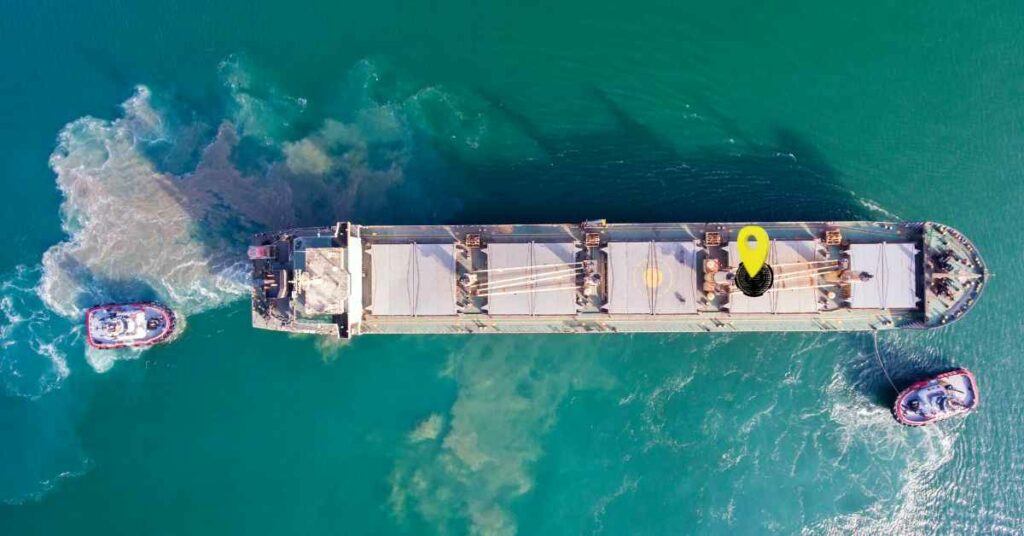

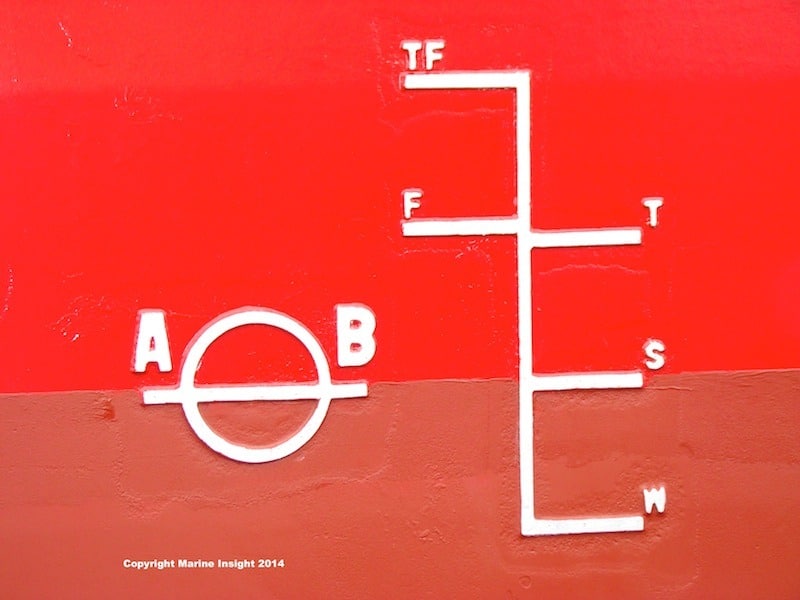

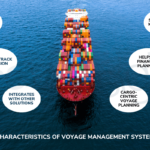
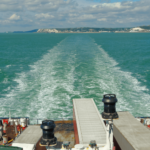
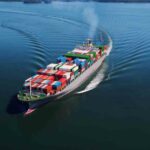



Wow, I never realized there were so many methods of mooring. I’m not much of a boater but have been tagging along with my uncle on his boat. He taught me about ship to ship mooring, but not these other ones. I like how you pointed out that a combination of breast, head, and spring ropes are best.
The mooring methods is very much and each mooring is unical. Usually we undestand standards methods for moorig, but in realy it is need to make some standards mooring methids. It is very important in mooring manouvering good comunication between all mooring members – master’s – pilot’s – ch. mate – mooring officers, sailors, tug’s masters, berth sailors. I’m tace in opinion not only tehnical comunication – loud speacers or portable VHF or spcial two way radio stations, but good communication between peoples.
I didn’t know there are so many mooring methods before reading your article that is very informative and impressive for me. These are standard mooring ways, for different mooring conditions, there will be specific mooring ways to suit the special environment requirements; during the mooring operations, safety should come first.
Is that in CBM anchor is used??? I have read elsewhere only messnger line helps to transfer the ships mooring to the different buoy around the ship and hepls the ship stay at a place doesnt allow to move like SPM. Here you have talked about use of anchor.can you provide any link or can you make video tutorial for all types of mooring system.thank you
Very nice irticle. I am a teacher for seaman. I want to use some part of your material in a handout to be given to candidates during training free of cost. Request your permission for it
@Capt. Devendra: You can use our articles by giving due credit to – https://www.marineinsight.com
For free ebooks, we need an official email from the institute.
How do you moor a ship in areas of drastic tide movements?
About buoy mooring.
How can we do mooring buoys with 3 meters of diameter?
The buoy are made by plastic and it has got long tail and ballast.